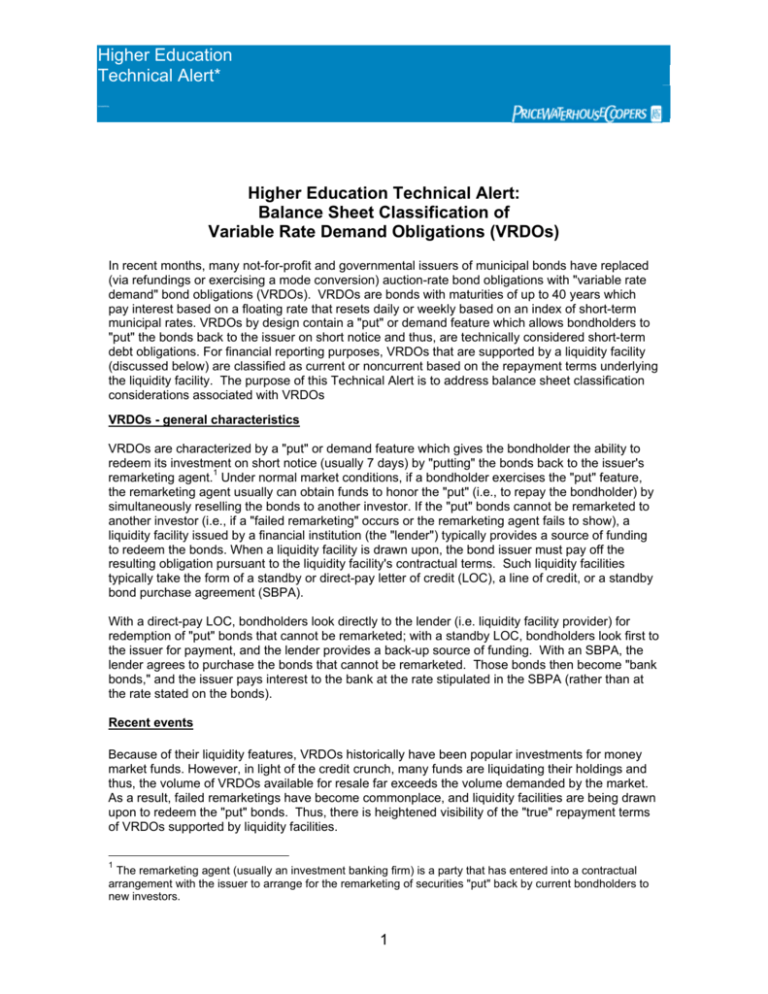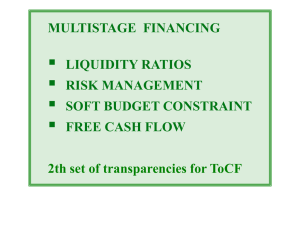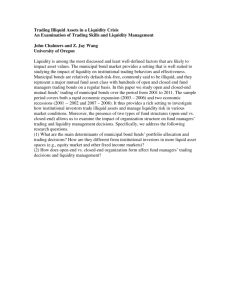
Higher Education
Technical Alert*
Higher Education Technical Alert:
Balance Sheet Classification of
Variable Rate Demand Obligations (VRDOs)
In recent months, many not-for-profit and governmental issuers of municipal bonds have replaced
(via refundings or exercising a mode conversion) auction-rate bond obligations with "variable rate
demand" bond obligations (VRDOs). VRDOs are bonds with maturities of up to 40 years which
pay interest based on a floating rate that resets daily or weekly based on an index of short-term
municipal rates. VRDOs by design contain a "put" or demand feature which allows bondholders to
"put" the bonds back to the issuer on short notice and thus, are technically considered short-term
debt obligations. For financial reporting purposes, VRDOs that are supported by a liquidity facility
(discussed below) are classified as current or noncurrent based on the repayment terms underlying
the liquidity facility. The purpose of this Technical Alert is to address balance sheet classification
considerations associated with VRDOs
VRDOs - general characteristics
VRDOs are characterized by a "put" or demand feature which gives the bondholder the ability to
redeem its investment on short notice (usually 7 days) by "putting" the bonds back to the issuer's
remarketing agent.1 Under normal market conditions, if a bondholder exercises the "put" feature,
the remarketing agent usually can obtain funds to honor the "put" (i.e., to repay the bondholder) by
simultaneously reselling the bonds to another investor. If the "put" bonds cannot be remarketed to
another investor (i.e., if a "failed remarketing" occurs or the remarketing agent fails to show), a
liquidity facility issued by a financial institution (the "lender") typically provides a source of funding
to redeem the bonds. When a liquidity facility is drawn upon, the bond issuer must pay off the
resulting obligation pursuant to the liquidity facility's contractual terms. Such liquidity facilities
typically take the form of a standby or direct-pay letter of credit (LOC), a line of credit, or a standby
bond purchase agreement (SBPA).
With a direct-pay LOC, bondholders look directly to the lender (i.e. liquidity facility provider) for
redemption of "put" bonds that cannot be remarketed; with a standby LOC, bondholders look first to
the issuer for payment, and the lender provides a back-up source of funding. With an SBPA, the
lender agrees to purchase the bonds that cannot be remarketed. Those bonds then become "bank
bonds," and the issuer pays interest to the bank at the rate stipulated in the SBPA (rather than at
the rate stated on the bonds).
Recent events
Because of their liquidity features, VRDOs historically have been popular investments for money
market funds. However, in light of the credit crunch, many funds are liquidating their holdings and
thus, the volume of VRDOs available for resale far exceeds the volume demanded by the market.
As a result, failed remarketings have become commonplace, and liquidity facilities are being drawn
upon to redeem the "put" bonds. Thus, there is heightened visibility of the "true" repayment terms
of VRDOs supported by liquidity facilities.
1
The remarketing agent (usually an investment banking firm) is a party that has entered into a contractual
arrangement with the issuer to arrange for the remarketing of securities "put" back by current bondholders to
new investors.
1
Classification considerations for FASB organizations
As stated previously, VRDOs by design contain a "put" or demand feature which allows
bondholders to "put" the bonds back to the issuer on short notice and thus, are technically
considered short-term debt obligations. For VRDO issuers whose financial statements are
prepared in accordance with FASB standards, the principal guidance for evaluating the appropriate
balance sheet classification of short-term debt obligations is contained in ARB Opinion No. 43
(ARB 43), Restatement and Revision of Accounting Research Bulletins, Chapter 3a; FASB
Statement No. 6 (FAS 6), Classification of Short-Term Obligations Expected to be Refinanced;
FASB Statement No. 78 (FAS 78), Classification of Obligations That Are Callable by the Creditor,
and EITF Topic D-61, Classification by the Issuer of Redeemable Instruments that are Subject to
Remarketing Agreements. ARB 43 defines current liabilities as “obligations whose liquidation is
reasonably expected to require the use of existing resources properly classifiable as current
assets, or the creation of other current liabilities.” FAS 6 amended ARB 43 to clarify that the
current liability classification is intended to include obligations that, by their terms, are due on
demand or will be due on demand within one year (or operating cycle, if longer) from the balance
sheet date, even though liquidation may not be expected within that period. FAS 78 clarifies how
obligations that are callable by the creditor should be presented in a balance sheet in which
liabilities are classified as current or noncurrent. Topic D-61 states that the presence of a "bestefforts" remarketing agreement2 (typical for VRDO issuances) should not be considered when
evaluating current vs. noncurrent classification.
Therefore, unless the VRDO issuer has the ability and intent to refinance the debt on a long-term
basis as provided for in FAS 6, VRDOs should be classified as a current liability. Because a
liquidity facility provides the issuer with an ability to refinance, issuers must carefully evaluate the
terms of their liquidity agreements in light of FAS 6 for attributes that might impact balance sheet
classification of the debt, including:
•
•
•
•
•
Expiration date of the commitment. To support long-term (i.e., noncurrent) classification,
the liquidity facility must extend the repayment terms of the VRDOs beyond one year from
the balance sheet date. VRDOs supported by agreements that expire within one year of
the balance sheet must be classified as current. In making that determination, FAS 6
paragraph 11 indicates that consideration should be given to renewals of liquidity facilities
that occur subsequent to year-end but prior to financial statement issuance.
Covenant violations. Violations of covenants set forth in the liquidity agreements could
cause termination of the agreement or demand for immediate repayment of any draws.
Inclusion of subjective acceleration, material adverse event, or similar clauses. The
existence of such clauses, which provide the lender with the ability to demand repayment
based on subjective (rather than objective) criteria, typically would preclude classification of
the VRDOs as noncurrent.3
Repayment terms. The repayment terms of the liquidity facility will impact the
determination of amounts due within one year of the balance sheet date (and thus, the
amount of the VRDOs that must be classified as a current liability). Some liquidity facilities
have repayment terms that are installment-based; others require a balloon payment at the
facility’s expiration date.
Ability to cancel. The lender should not have the ability to cancel the credit facility without
cause within one year from the balance sheet date.
Illustrations of guidance
2
In a best-efforts remarketing agreement, the agent agrees to buy only those securities that it is able to sell to
the public. If the agent is unable to remarket the debt, the issuer is obligated to pay off the debt.
3
See EITF Topic D-23, Subjective Acceleration Clauses and Debt Classification, and related literature.
2
Note: These examples should not be a substitute for reviewing and understanding the underlying
bond documents and credit facilities and considering the appropriate application of guidance to
specific client situations.
Assume that on April 1, 2007, an organization issued 30-year VRDOs. Simultaneously, the
organization enters into a standby letter of credit (LOC) agreement with a financial institution to
provide backup liquidity in the event the bonds are "put" back to the organization. Unless otherwise
indicated, the LOC is noncancellable and contains no subjective acceleration clauses. The
organization's fiscal year ends on December 31. Under each of the following fact patterns
involving the LOC, what is the appropriate balance sheet classification of the VRDOs at December
31, 2007?
a. The LOC has a one-year term. If the facility is drawn upon, a balloon payment will be
due at maturity (March 31, 2008).
Because the LOC will expire on March 31, 2008 (i.e., within one year of the
December 31, 2007 balance sheet date), all of the debt should be classified as
current.
b. Same facts as (a), except that prior to the issuance of the December 31, 2007 financial
statements, the organization renews the LOC for an additional 365 days, extending the
terms through March 31, 2009.
Because the LOC was renewed prior to the issuance of the financial statements to
extend the repayment of any draws until March 31, 2009 (i.e., beyond one year
from the balance sheet date), FAS 6, paragraph 11(b) indicates that the VRDOs
can be classified as noncurrent as long as (i) no covenant violations that would
accelerate the debt occurred prior to the balance sheet date4 and no available
information indicates a violation has occurred prior to issuance of the financial
statements and (ii) the lender is a viable financial institution.
c. The LOC expires on June 30, 2008. The December 31, 2007 financial statements must
be issued within 90 days of year end (i.e., by March 30, 2008). As of March 30th, no
commitment to renew the line had been obtained from the financial institution.
Because the LOC will expire within one year of the balance sheet date (i.e., on
June 30, 2008) and no evidence exists of the organization's ability and intent to
renew the line (e.g., in the form of a commitment from the lender) prior to issuance
of the financial statements on March 30, 2008, the debt should be classified as
current.
d. The LOC has a five-year term. If the facility is drawn upon, a balloon payment will be
due at maturity (March 31, 2012).
Because the LOC irrevocably extends repayment beyond one year from the
December 31, 2007 balance sheet date (i.e., until March 31, 2012) and no other
conditions exist that would make amounts drawn against the LOC payable on
demand (e.g., inclusion of a subjective acceleration clause), the VRDOs would be
classified as noncurrent.
e. Same as (d), except that repayment of any draws would be due pro-rata every month
over a two-year period from the date of draw down.
4
See EITF 86-30, Classification of Obligations When a Violation Is Waived by the Creditor.
3
The organization must assume that a "put" of all of the VRDOs will occur on the
first day of the subsequent period (i.e., January 1, 2008), and then calculate the
portion that must be repaid within one year of the December 31, 2007 balance
sheet date (in this fact pattern, one-half of the VRDOs). A portion of the debt
corresponding to that amount must be classified as current; the balance can be
classified as noncurrent.
f. Same as (d), except that the LOC's terms contain a subjective acceleration clause giving
the financial institution the right to call any amounts drawn as immediately due and payable
if, in the bank's view, a "material adverse event" occurs.
Because the lender has the ability to subjectively accelerate repayment of any
draws against the LOC, all of the VRDOs must be classified as current.
g. Same as (d), except that the LOC is cancellable by either the organization or the lender
on November 1 of each year, without cause.
Because the lender has the ability to cancel the LOC without cause, the
organization must assume that cancellation will occur on November 1, 2008. As
this date is within one year of the December 31, 2007 balance sheet date, the
VRDOs must be classified as current.
Classification considerations for GASB proprietary funds/activities
GASB addressed the classification of demand obligations of proprietary funds in GASB
Interpretation 1, Demand Bonds Issued by State and Local Government Entities, paragraph 9.
That guidance is similar to the FAS 6 model; it indicates that demand bonds should be excluded
from current liabilities of proprietary funds only if all of the following conditions are met:
•
Before the financial statements are issued, the government has entered into an arm'slength financing agreement to convert bonds "put" but not resold into some other form
of long-term obligation (e.g. via a liquidity facility);
•
The liquidity facility does not expire within one year of the balance sheet date;
•
The liquidity facility is not cancellable by the lender or the prospective lender during that
year, and obligations incurred under the liquidity facility are not callable by the lender
during that year; and
•
The lender or the prospective lender or investor is expected to be financially capable of
honoring the liquidity facility during that year.
Consistent with the FASB examples above, any portion of the government's demand obligations
that must be repaid within one year must be classified as current. Additional guidance can be
found in section D30.107 of the GASB codification.
"Self-liquidity" facilities
The demand for and cost of liquidity facilities has increased significantly in light of recent market
events. As a result, some organizations are turning to "self-liquidity" facilities to provide back-up
funding in the event that demand obligations are "put." Self-liquidity facilities may require that an
organization formally set aside (i.e., board-designate) cash for funding any "puts" that occur.
Because there is no third party providing liquidity that would effectively allow the organization to
4
refinance the debt on a long-term basis, organizations that use self-liquidity facilities must classify
the VRDOs as a current liability.
Example
Assume that on April 1, 2007, an organization issued 30-year VRDOs. The organization opts for
self-liquidity; that is, it will fund any "puts" from assets set aside for long-term expansion and
construction (and thus, classified as noncurrent). What is the appropriate balance sheet
classification of the VRDOs at the organization's fiscal year end of December 31, 2007?
Because there is no external financing structure in place that allows the organization to
effectively extend the repayment of the debt beyond one year of the balance sheet date,
the VRDOs must be classified as a current liability. The fact that the "puts" would be
satisfied from assets classified as noncurrent is irrelevant.
Recommendations
−
The importance of reading and understanding the terms of documents associated with demand
or "puttable" debt obligations (i.e., bond indentures, loan and trust agreements, liquidity facility
agreements, etc.) is paramount for determining the appropriate balance sheet classification.
−
In the current environment, the increased occurrence of failed remarketings and resulting
draws upon liquidity facilities may create or exacerbate liquidity problems for issuers. If a
significant amount of bonds are tendered, the issuer is forced to repay those obligations based
on the much-shorter debt repayment schedule of the liquidity facility, rather than based on the
expected maturity of the bonds. Additionally, some issuers may find that their liquidity
providers are unwilling or unable to stand behind their commitments, due to occurrence of a
negative credit event involving the issuer (such as a ratings downgrade trigger) which allows
the lender to terminate the facility prior to its expiration date, or due to financial problems or
bankruptcy of the lender. Additionally, classification of debt as current versus noncurrent may
cause significant swings in liquidity ratios. Organizations and engagement teams should
consider the implications of such matters when assessing debt covenant compliance, liquidity,
and going concern.
−
Additionally, engagement teams should consider the adequacy of management's debt-related
financial statement disclosures to ensure that the risks and uncertainties associated with
VRDOs and related liquidity facilities are transparent to the users of the financial statements.
Questions
Questions relating to this Technical Alert should be directed to Dave Merriam (973-236-4995),
Steve Luber (973-236-4957), Brian Huggins (973-236-5612), Jeff Thomas (973-236-5044) or
Martha Garner (973-236-7294) in the National Professional Services Group. Questions related to
specific client circumstances should be directed to a financial instruments consultant in the National
Professional Services Group (973-236-7803).
© 2008 PricewaterhouseCoopers. All rights reserved. PricewaterhouseCoopers refers to the network of member firms of
PricewaterhouseCoopers International Limited, each of which is a separate and independent legal entity.
PricewaterhouseCoopers has taken all reasonable steps to ensure that information contained herein has been obtained
from reliable sources and that this publication is accurate and authoritative in all respects. However, it is not intended to give
legal, tax, accounting or other professional advice. If such advice or other expert assistance is required, the services of a
competent professional should be sought.
5










